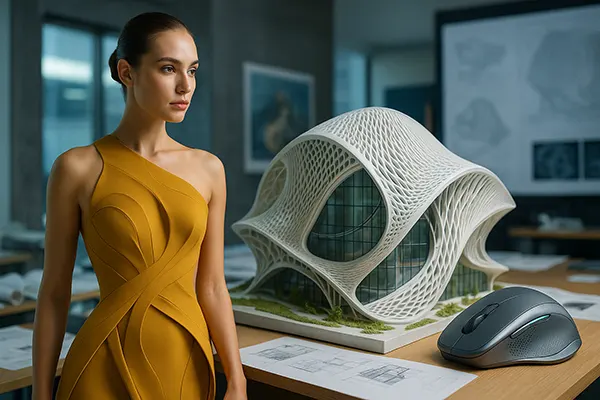AI Designers: How Neural Networks Shape Fashion, Architecture and Product Design

Artificial intelligence is no longer just a tool for analysing data or automating processes—it has evolved into a creative partner. AI-powered design is actively transforming key industries like fashion, architecture, and industrial product development. By 2025, neural networks have become part of the core creative process, generating not only ideas but fully visualised, functional concepts based on real-time data, user preferences, and even cultural trends. This fusion of human creativity and machine learning marks a new chapter in design innovation.
Fashion Design Reinvented by AI Collaboration
Fashion is no longer dictated solely by seasonal intuition or tradition. Neural networks now interpret global trends from social media, environmental data, and purchasing behaviours to suggest new materials, colour palettes, and cuts. Designers use tools like CLO 3D, Fashwell, or RunwayML to test and prototype ideas virtually in a matter of hours, reducing waste and accelerating production cycles. These models also enable accurate predictions of garment popularity before physical production begins.
Brands such as Tommy Hilfiger and Zalando already use AI algorithms to tailor collections to market-specific preferences. Designers are empowered with pattern generation, mood board automation, and material simulation, enabling more inclusive and functional fashion. Moreover, AI assists with sustainable practices by identifying environmentally friendly alternatives and optimising supply chains.
In 2025, consumer-facing apps allow personalised fashion recommendations based on user body scans and style history. Generative models even simulate how garments behave in motion, helping shoppers make informed choices and reducing return rates. AI in fashion is no longer optional—it’s part of competitive survival and innovation.
Emerging Fashion Aesthetics Driven by AI
The aesthetics born from neural network input often break conventional design logic, creating abstract, asymmetrical, or biomimetic styles. AI-generated designs challenge the norms of symmetry, functionality, and wearability, offering a bold rethinking of how clothing interacts with identity. Avant-garde designers collaborate with algorithms to develop one-of-a-kind digital fabrics and prints, now used both in physical garments and virtual fashion spaces.
This era has also given rise to “phygital” fashion—digital-first clothing that may never exist physically but plays a role in virtual social interactions and gaming. Platforms like DRESSX and The Fabricant offer users ways to express themselves via digital clothing, influenced heavily by generative AI tools. These models respond to users’ visual preferences, creating personal fashion statements in immersive environments.
Even high couture is exploring AI’s potential. For instance, Iris van Herpen collaborates with machine-learning systems to explore fractal geometry in garment construction. AI doesn’t replace creativity—it amplifies it, suggesting paths the human mind might never have imagined independently.
Architectural Design through Neural Interpretation
Architecture, once a domain of rigid blueprints and engineering constraints, now benefits from fluid generative processes. Neural networks like Midjourney or Autodesk’s generative tools assist architects in creating forms optimised for energy efficiency, environmental conditions, and human behaviour patterns. AI can test thousands of design iterations based on client needs and site data, accelerating early concept development from weeks to days.
These algorithms also help reduce environmental impact. AI tools simulate how natural light moves through a structure, suggesting optimal layouts for windows and insulation. In cities facing climate crises, AI-generated green roofs, ventilation systems, and passive solar designs have become integral in achieving zero-carbon construction goals.
Moreover, AI is redefining spatial aesthetics. Organic, flowing forms that mimic nature—such as tree branches, coral, or bone structures—are increasingly prevalent in modern architecture. This shift is largely driven by neural models trained on biological datasets, which propose designs optimised for both strength and aesthetic harmony.
From Urban Planning to Parametric Facades
Neural networks assist urban planners in simulating pedestrian flow, traffic patterns, and even socio-economic dynamics. These predictive models improve decision-making in real time, enabling cities to adapt to growth, migration, and climate conditions more intelligently. From transport hubs to public parks, AI helps visualise and test solutions before a single brick is laid.
In façade design, AI generates intricate parametric skins that adjust based on climate or daylight. Such façades are not just decorative but functional—controlling ventilation, light, and thermal exposure dynamically. This results in buildings that interact with their environments more intelligently, offering both beauty and resilience.
Architects also benefit from AI in heritage conservation. Tools trained on historical archives can reconstruct damaged architecture with high precision, offering digital twins and 3D renderings used for restoration or education. In short, AI supports both innovation and preservation.

Product Design in the Age of Algorithmic Creativity
AI transforms product design into a data-responsive process. From furniture to consumer electronics, neural networks analyse ergonomics, materials science, and user feedback to generate efficient, aesthetic designs. Designers use tools like Gravity Sketch, Adobe Firefly, and neural rendering engines to visualise concepts in real time and assess functional performance.
Companies like Logitech and Dyson implement AI to simulate product use cases—modelling how users interact with devices across scenarios. This allows earlier detection of design flaws and better adaptability to user habits. Furthermore, AI identifies redundancies in production, reducing costs and material waste significantly.
Personalisation is a growing trend in product development. AI enables mass customisation by offering user-specific modifications without disrupting the production workflow. Customers can co-design elements, such as colours, shapes, and functions, with AI suggesting optimal combinations based on ergonomics and user profiles.
Ethics, Innovation, and Intellectual Ownership
Despite the breakthroughs, AI-assisted design raises ethical concerns. Who owns the design generated by an algorithm? How do we attribute creative authorship when outputs result from training on collective human data? These are questions that designers, developers, and legislators are addressing in 2025 through new policies and creative licensing models.
Another key issue is the potential homogenisation of design. While neural networks are powerful, excessive reliance may lead to aesthetic convergence, where everything looks similarly optimised. Designers must therefore use AI as a collaborator—not a creative replacement—to maintain uniqueness and human context.
Nevertheless, AI opens new frontiers for inclusivity, sustainability, and functionality in design. With thoughtful use, machine learning becomes a bridge—not a barrier—to human-centred creativity, transforming how we build, dress, and interact with the world around us.
